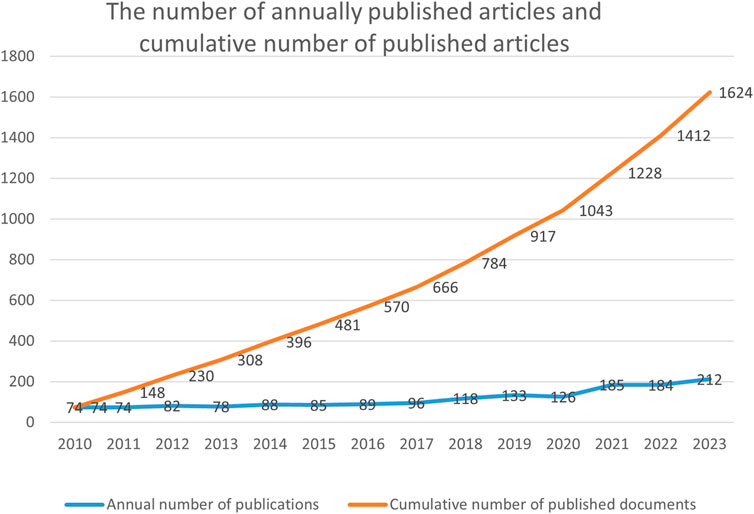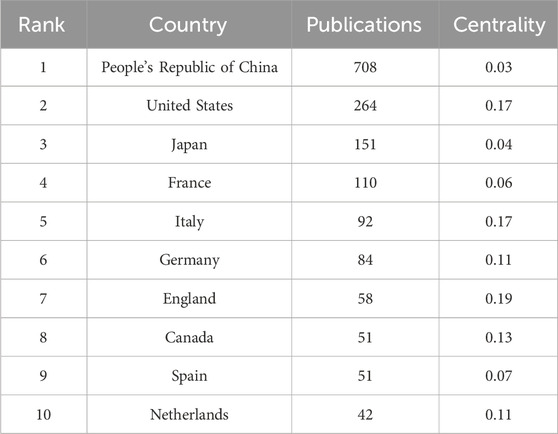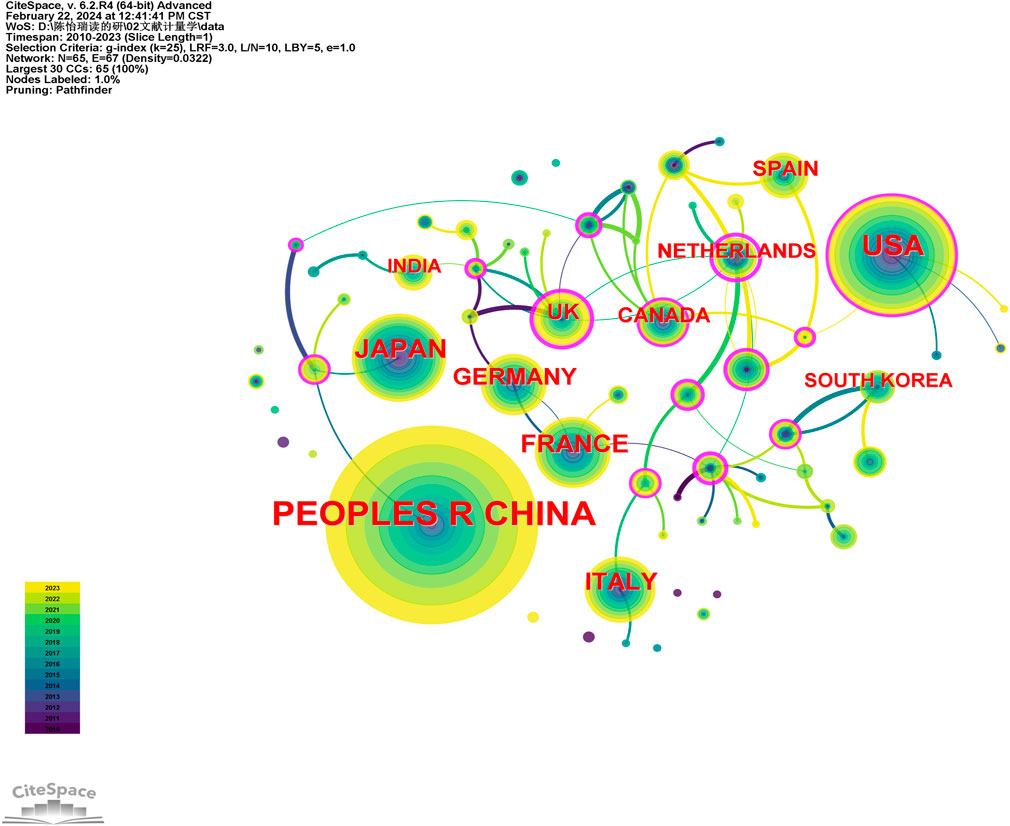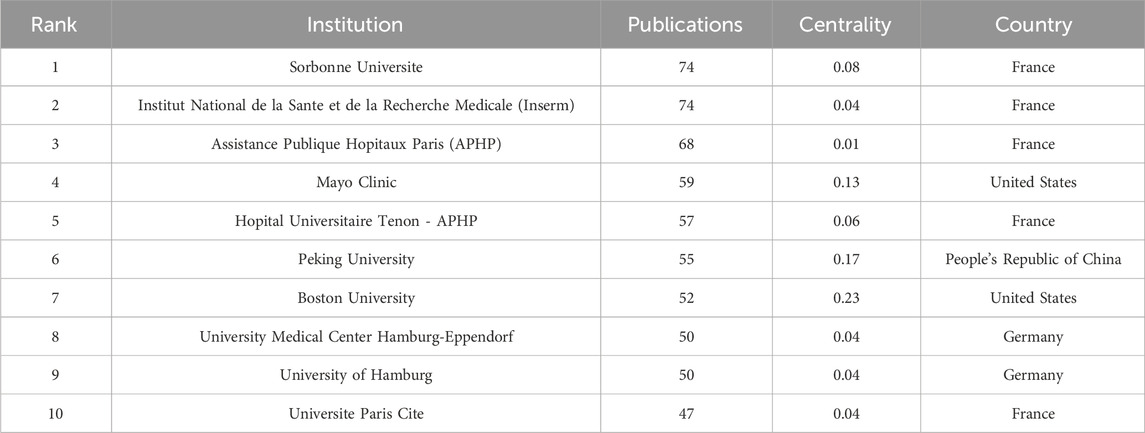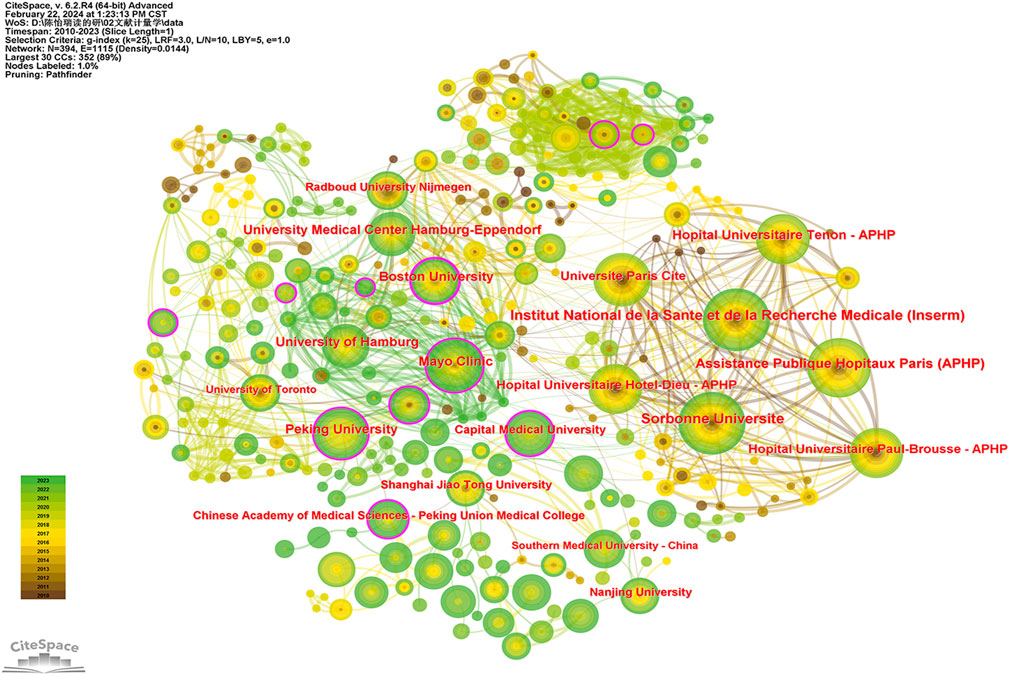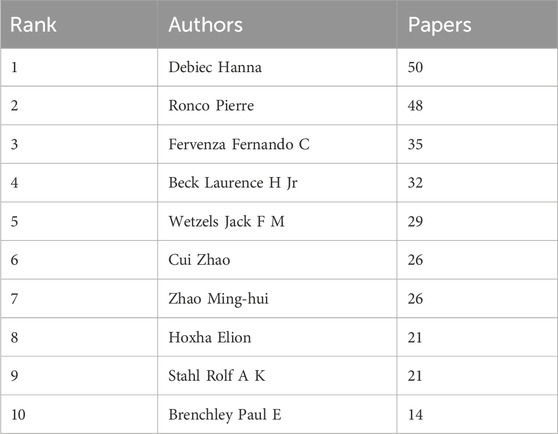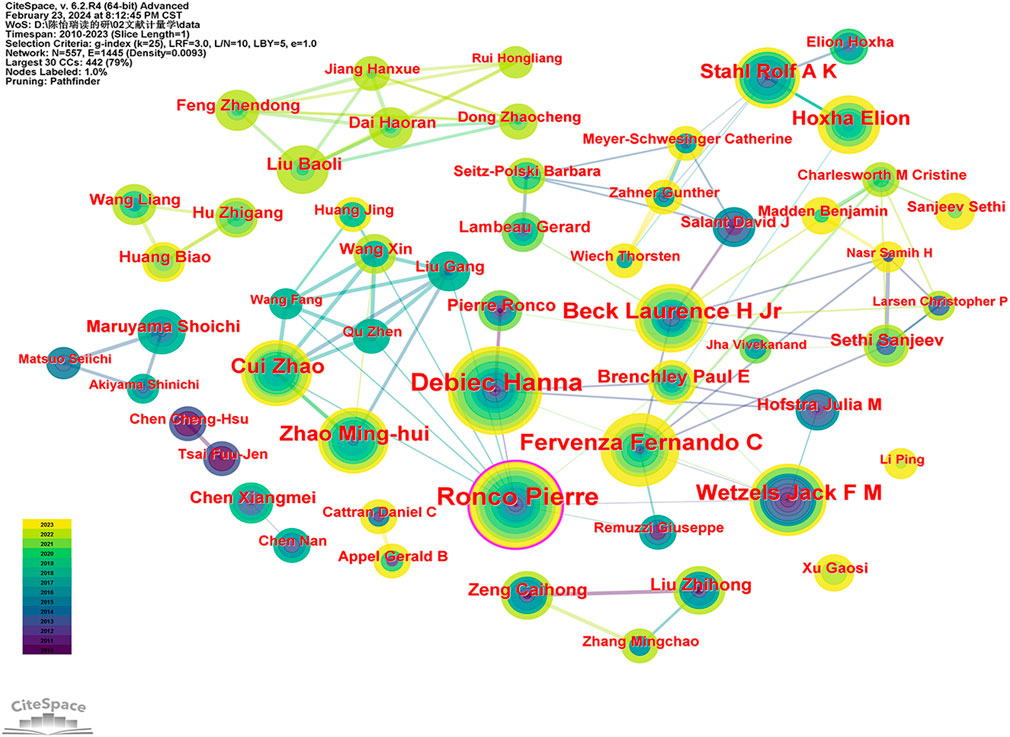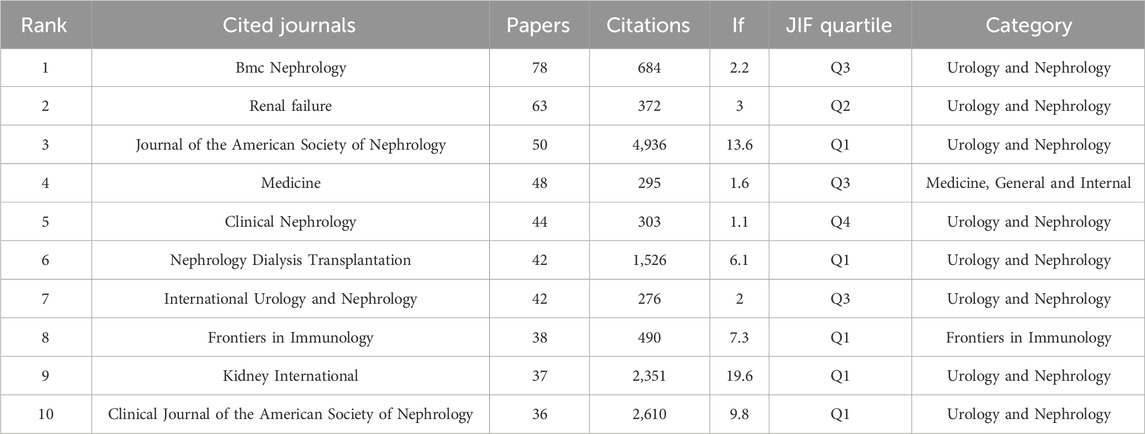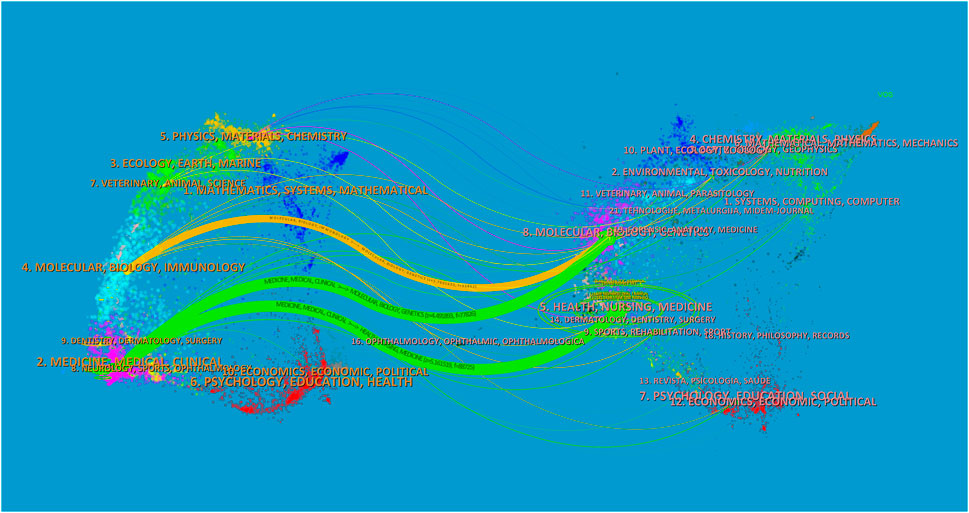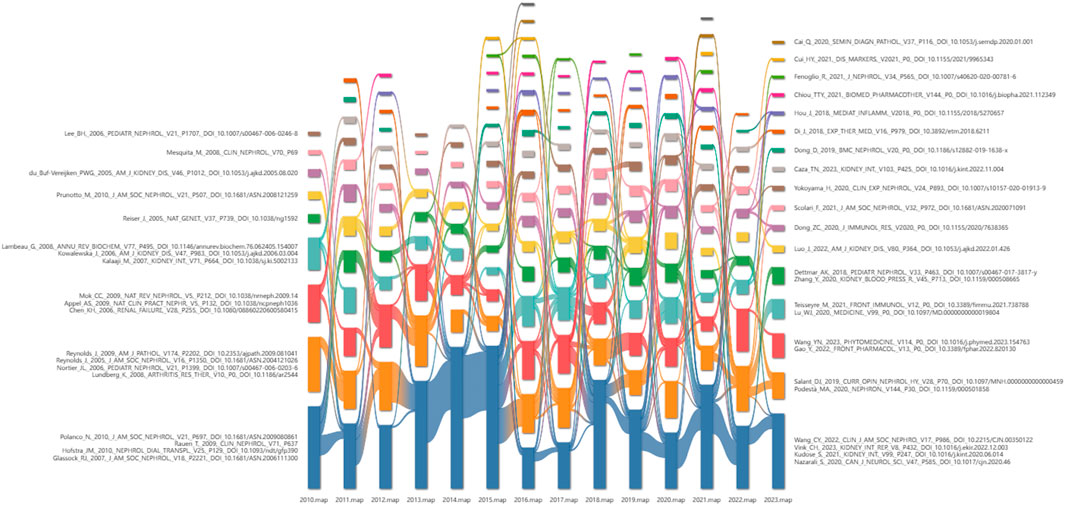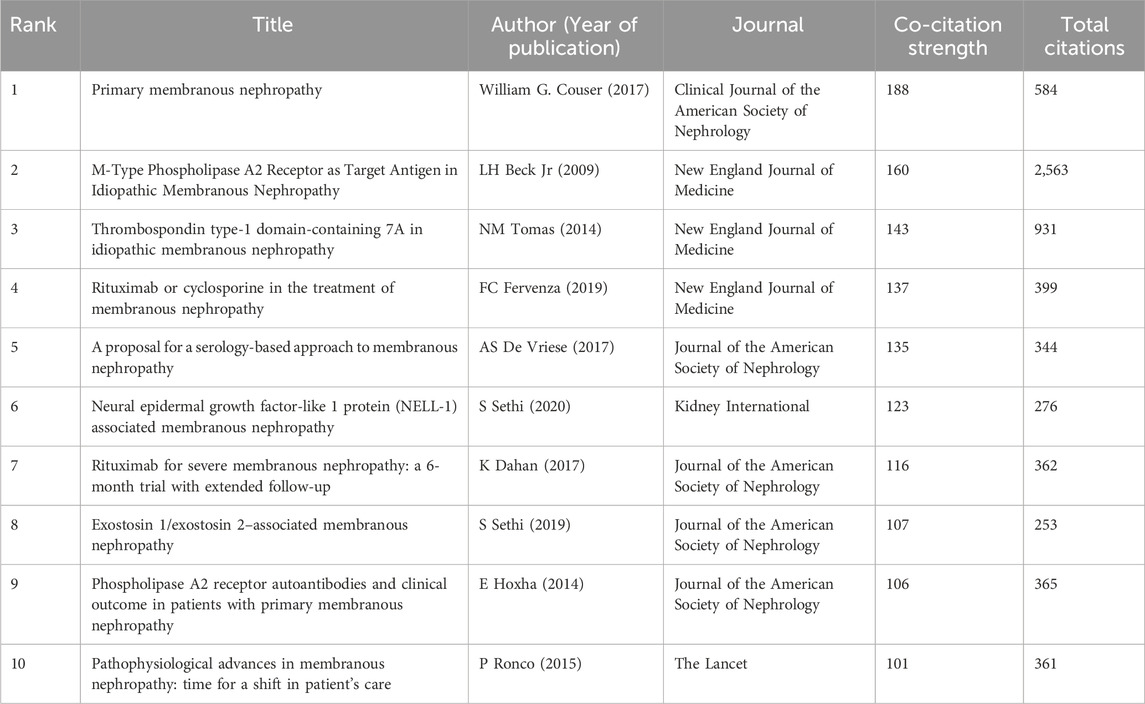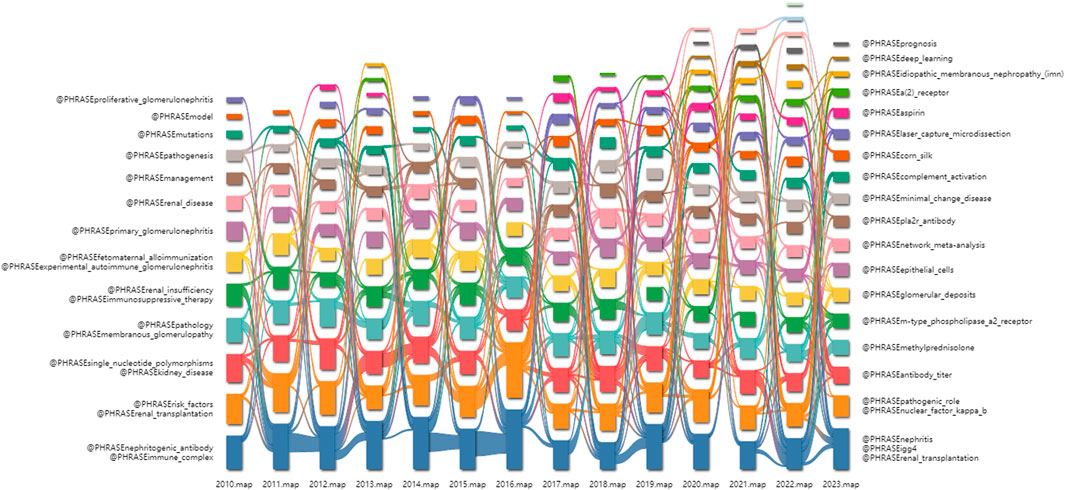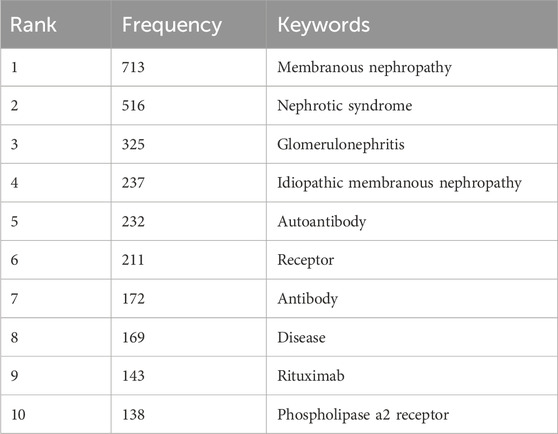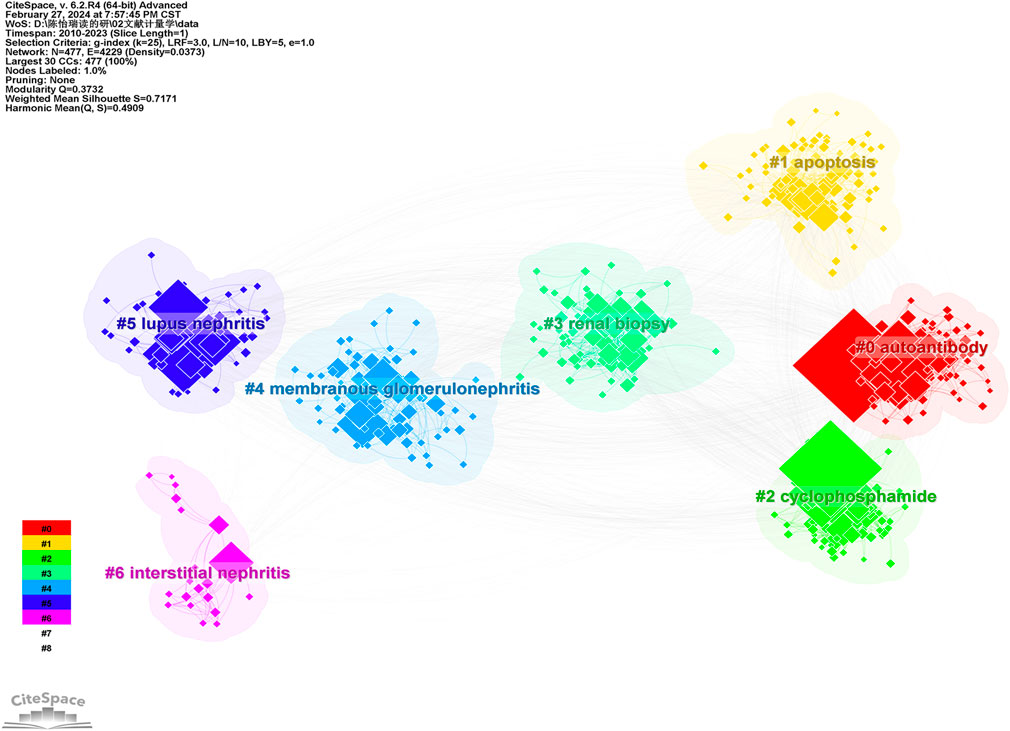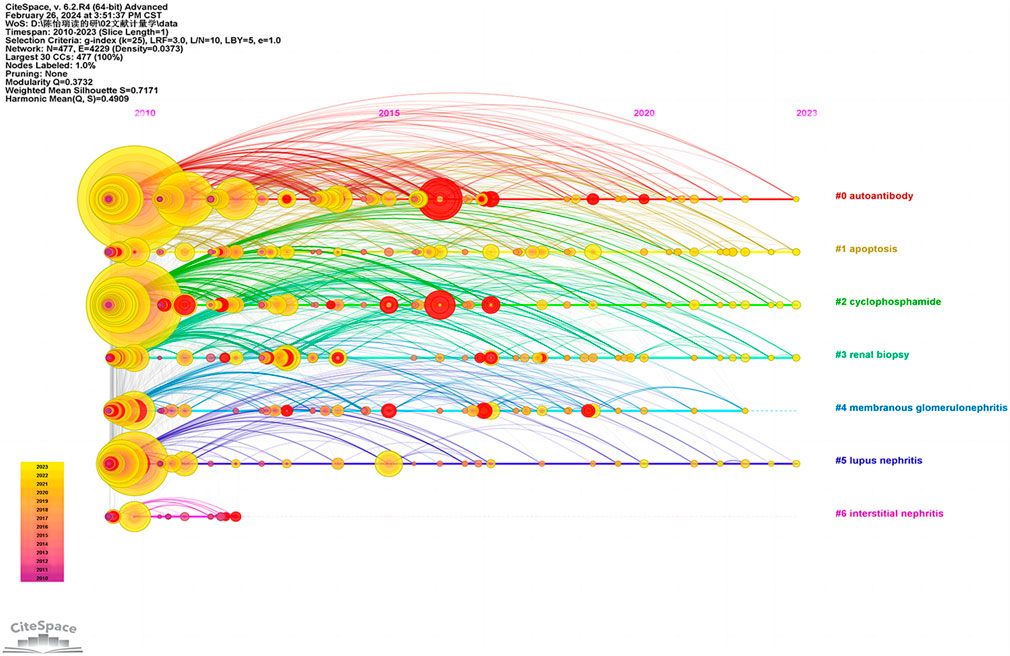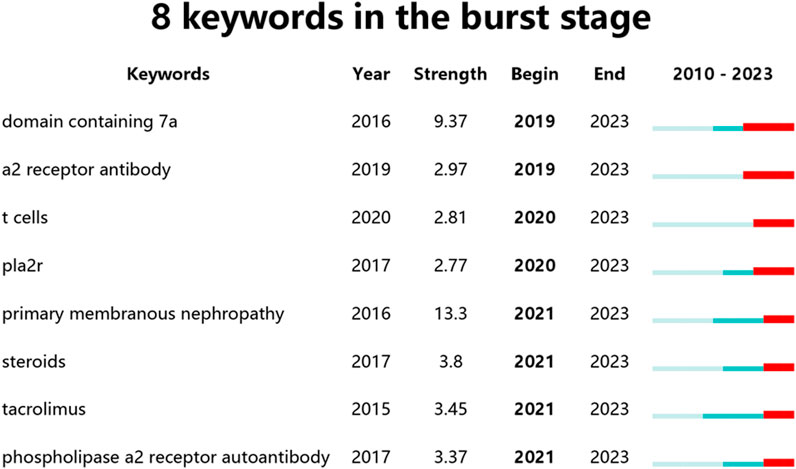- 1Wenzhou Hospital of Traditional Chinese Medicine, Affiliated with Zhejiang Chinese Medical University, Wenzhou, China
- 2The Third School of Clinical Medicine, Zhejiang Chinese Medical University, Hangzhou, China
- 3The First Affiliated Hospital of Wenzhou Medical University, Wenzhou, China
Background: Membranous glomerulonephritis, also known as membranous nephropathy (MN), is a common cause of nephrotic syndrome in adults. Despite extensive research on MN, bibliometric studies on the subject are scarce. Therefore, this study aimed to provide a visual analysis of global trends in membranous nephropathy research over the past 13 years.
Methods: This study conducted a bibliometric and visual analysis of global trends in MN research from 2010 to 2023. Articles related to MN were retrieved from the Web of Science Core Collection (WoSCC) database. Tools such as CiteSpace and VOSviewer were utilized to analyze publications, countries, institutions, authors, publishing journals, co-cited references, and keywords to identify the current state and future trends in MN research.
Results: The analysis encompassed 1,624 publications, showing an annual increase from 2010 to 2023. The People’s Republic of China emerged as the most active country in this field, while France’s Sorbonne Universite and Institut National de la Sante et de la Recherche Medicale (Inserm) led in publication volume among academic institutions. Debiec Hanna stood out as the most prolific author. BMC Nephrology had the highest number of publications, making it the most favored journal in the field. The article with the greatest co-citation intensity was “Primary Membranous Nephropathy,” a review published in 2017.
Conclusion: This study shows that there has been increasing interest in membranous nephropathy over the past 13 years. The most frequently encountered keywords were “membranous nephropathy” “nephrotic syndrome,” and “glomerulonephritis.” Analysis of emerging terms indicated that “a2 receptor antibody,” “domain containing 7a,” and “t cell” may remain prominent subjects of research in the forthcoming years. The findings highlight key research trends and areas of interest that can inform researchers, clinicians, and policymakers about the current state of MN research and help guide future research directions and clinical practice.
1 Introduction
Membranous nephropathy (MN) is the most common cause of idiopathic nephrotic syndrome in non-diabetic adults (Couser, 2017). While it can occur at any age, it is predominantly seen in adults, with a peak incidence between 36 and 40 years and a male to female ratio of 2:1 (Couser, 2017). MN often begins insidiously, with some cases preceded by an infection (Ronco et al., 2021). The initial symptom is usually a gradually worsening swelling of both lower limbs, with most cases presenting significant proteinuria and manifesting as nephrotic syndrome (Liu et al., 2016). MN is thought to result from glomerular damage caused by autoantibodies against antigens on the membranes of normal podocytes. It is characterized by the deposition of subepithelial immune complexes and thickening of the basement membrane, visible under light and electron microscopy, often forming spikes (Infantino, 2022). The evidence suggests the immune deposits include Immunoglobulin G and significant antigens such as phospholipase A2 receptor (PLA2R) (Yang et al., 2021) and thrombospondin type-1 domain-containing 7A (THSD7A) (Tomas et al., 2014).
Bibliometrics is a method that applies mathematical and statistical techniques for qualitative and quantitative analysis of publications within a specific field. This approach utilizes data analysis to evaluate the current research landscape, identify hot topics, and forecast the future direction of a discipline, offering a timely and intuitive means for delving into specific areas (Ninkov et al., 2022). As of now, there has been no bibliometric analysis conducted on MN. Hence, this study aims to review existing research and perform a systematic analysis to explore the state and trends of MN from 2010 to 2023. Using bibliometric analysis, with CiteSpace as the primary tool and VOSviewer as a supplement, this study examines publications, countries, institutions, authors, publishing journals, co-cited references and keywords within the field of MN. The goal is to summarize the current state of research and development, providing guidance for future research directions.
2 Materials and methods
2.1 Data source and search strategy
The Web of Science Core Collection (WoSCC) was utilized for data collection. Additionally, to ensure retrieval accuracy, we used topic retrieval and set the search terms to TS = (“membranous nephropathy” OR “idiopathic membranous nephropathy” OR “primary membranous nephropathy” OR “membranous glomerulonephritis”). The search concluded on 30 January 2024. Included publications were primarily articles and reviews, and the literature language was restricted to English. The data were saved and stored in the Plain Text File format.
2.2 Data extraction and processing
The WoSCC database comprised a total of 4,292 documents. After filtering for articles and reviews, 3,375 documents were obtained. Following manual thematic screening delete articles that are not related to the subject word and exporting in plain text, a total of 1,649 records meeting the criteria were gathered. After importing CiteSpace and removing duplicates, 1,624 samples were obtained. The study’s retrieval and selection process are illustrated in Figure 1. Since the data did not involve any identifiable patient information, this study did not necessitate an ethical review. Journal information, including impact factor (IF), Journal Impact Factor (JIF) quartile (Q1–Q4) and category, was collected from the 2022 Journal Citation Reports.
2.3 Statistical analysis
Statistical analyses were primarily conducted using CiteSpace (v6.2, R4), while VOSviewer 1.6.20 was employed for analyzing publishing journals and co-cited references statistics. CiteSpace settings included a 1-year “time slice” value, selection of different network clipping methods based on graphical complexity, the G-index factor K set to 25, and TopN% set at 10%. The configuration of image nodes and connections was tailored to the specific objective of each analysis. VOSviewer analysis was conducted using the default settings.
3 Results
3.1 Trend of global publications and citations
A total of 1,624 documents were included in this study. A line chart (Figure 2) was created to depict the quantity and overall count of publications on MN over the past 13 years (2010–2023), illustrating its progression. The vertical axis indicates the number of published papers, and the horizontal axis denotes the year. The total volume of publications over a certain period can objectively and quantitatively reflect the overall developmental trend of a field.
From 2010 to 2020, the growth rate of publications remained relatively stable. However, a notable increase in the number of publications occurred in 2019, reaching a peak in 2023.
3.2 Countries/regions analysis
The articles included in this study originate from 67 different countries, with over half of the articles coming from the top three countries. China leads with the highest number of articles (708, 35.3%), followed by the United States (264, 13.2%), and Japan (151, 7.5%), as depicted in Table 1. Utilizing CiteSpace to examine country nodes, Figure 3 presents a collaborative network map among countries, revealing extensive international collaboration.
Despite having a relatively low publication count (15, 0.007%), Sweden emerges as the country with the highest centrality (0.20). In the top 10, England (0.19), Italy (0.17), and the United States (0.17) exhibit higher centrality, underscoring their significant roles in international collaborations.
3.3 Institution analysis
A total of 393 institutions have published papers related to MN, with the top 10 publishing institutions outlined in Table 2 (Alphabetical order if publications and centrality are the same). The Sorbonne Universite (74, 0.08) tops the list with a high number of publications and a higher centrality than the Institut National de la Sante et de la Recherche Medicale (74, 0.04), followed by Assistance Publique Hopitaux Paris (APHP) (68, 0.01), with the leading three institutions all based in France. This highlights the significant interest and focus of French institutions in the field of MN.
With institutions represented as nodes, an institutional co-occurrence map was created (Figure 4). Boston University (0.23) in the United States is identified as a core entity in inter-institutional cooperation, with Peking University (0.17) and Capital Medical University (0.16) also playing key roles in these collaborations. The network density of the institutional co-occurrence graph stands at 0.0144, indicating a lack of overall collaboration among institutions researching MN. Enhancing cooperation between institutions, and leveraging the unique resources and information each possesses, could significantly benefit the advancement of the field.
3.4 Author analysis
A total of 554 authors have made contributions to the field of MN. Table 3 (sorted alphabetically by name if the number of papers is the same) lists the 10 authors with the highest number of publications. Debiec Hanna is the most prolific author with 50 publications, followed closely by Ronco Pierre (48) and Fervenza Fernando C (35) as the second and third most prolific authors, respectively.
Using CiteSpace, an author collaboration network graph was generated (Figure 5). According to Price’s law, the minimum number of publications required for core authors is n = 0.749
3.5 Journals analysis
According to VOSviewer analysis, a total of 3,714 journals have published articles relevant to the field. Table 4 displays the top 10 journals. BMC Nephrology published the most articles (78), followed by Renal Failure (63), and the Journal of the American Society of Nephrology (50). The majority of the top 10 journals fall within the nephrology category, with half of them ranked in WoS Q1. Kidney International has the highest Impact Factor (IF) at 19.6, indicating that the literature on MN is generally of high quality. Journal information, including impact factor (IF), Journal Impact Factor (JIF) quartile (Q1–Q4) and category, was collected from the 2022 Journal Citation Reports.
Additionally, we generated a dual-map overlay with CiteSpace (Figure 6), identifying three principal citation trajectories (two in green and one in orange). These trajectories consist of a citing map on the left and a cited map on the right. The majority of studies were published in journals categorized under medicine, medical, and clinical disciplines and were commonly cited in articles related to health, nursing, and medicine.
3.6 Analysis of co-cited references
Using CiteSpace depicts the alluvial flow map of co-cited references from 2010 to 2023 (Figure 7), revealing that certain co-cited references were extensively cited during the 2015–2023 period. Table 5 lists the ten papers with the highest co-citation intensity, encompassing five reviews and five articles. According to CiteSpace analysis, the publication with the highest co-citation intensity is “Primary Membranous Nephropathy,” a review by William G. Couser, published in the Clinical Journal of the American Society of Nephrology in 2017, receiving a total of 584 citations. This review addresses the etiology, pathogenesis, pathology, clinical manifestations, treatment, and prognosis of primary MN (Couser, 2017). The most cited article is “M-Type Phospholipase A2 Receptor as Target Antigen in Idiopathic Membranous Nephropathy” by L. H. Beck Jr, published in 2009. It identified the presence of PLA2R in the normal podocytes and immune deposits of most patients with idiopathic MN (Beck et al., 2009).
3.7 Analysis of keywords
Figure 8 illustrates the evolution of keywords over time via citespace. In 2010, “nephritogenic antibody” and “immune complex” were among the most frequently used keywords. As time progressed to 2023, the predominant keywords shifted to “nephritis,” “igg4,” and “renal transplantation.”
Table 6 lists the ten most frequently occurring keywords, with three of them being part of the search terms used, indicating a high degree of homogeneity in the literature related to MN. The most common keywords included “membranous nephropathy” (713), “nephrotic syndrome” (516), and “glomerulonephritis” (325).
The knowledge map of keyword clustering reveals seven clustering patterns within the field of MN research (Figure 9), with a modularity Q of 0.3732 and a mean silhouette value S of 0.7171. These values indicate that the keywords exhibit a diverse range of characteristics, and the clustering structure is both significant and compelling, enabling the identification of research hotspots. The primary labels for our keyword clusters include “autoantibody”, “apoptosis”, “cyclophosphamide”, “renal biopsy”, “membranous glomerulonephritis”, “lupus nephritis”, and “interstitial nephritis”.
As shown in the timeline view (Figure 10), “autoantibody”, “apoptosis”, “cyclophosphamide”, “renal biopsy” are popular keywords in recent years (2010–2023), and cluster sizes are 96, 89, 80, and 75, respectively.
Recent burst keywords were selected to create eight keywords in the burst stage (Figure 11), where the red lines represent periods of keyword surges. This visualization demonstrates that “domain containing 7a,” “a2 receptor antibody,” “t cells,” “pla2r,” “primary membranous nephropathy,” “steroids,” “tacrolimus,” “phospholipase A2 receptor,” and “autoantibody” are current research hotspots and potential targets within this field.
4 Discussion
4.1 General information
This study conducted an analysis of the MN literature from 2010 to 2023. The findings indicate that the publication growth rate has remained relatively stable over the past 13 years, with a significant surge in scholarly output observed in 2019. This surge can be attributed to advancements in glomerular laser microdissection and mass spectrometry techniques, facilitating research and antigen identification (Ronco and Debiec, 2021). Based on current trends, the volume of publications is anticipated to continue its upward trajectory into 2024.
Among the top ten most productive countries in MN research, only two are from East Asia, with China being the sole representative from the developing world. Industrialized countries commonly attribute the genesis of immune disorders to environmental factors. For instance, workers in construction and those exposed to occupational toxins such as asbestos, lead, and organic solvents are considered at an increased risk for MN (Cremoni et al., 2022). While China takes the lead in publication volume, possibly due to robust economic growth and extensive industrialization, environmental protection remains a challenge that potentially explains the rising incidence of MN (Xu et al., 2016). China’s low centrality indicates potential benefits from enhanced cooperation and development in related fields, as well as the production of high-quality articles. Research on the genetic and ethnic aspects of MN is centered around Caucasian populations in Western countries, including the UK, France, and the US (Stanescu et al., 2011). This focus may explain the higher centrality values of these countries compared to China, suggesting that despite China’s significant volume of research, the international impact in terms of collaboration and citations may be more pronounced in Western nations. Genetic heterogeneity and geographic variations in allele frequencies are observed among Chinese populations, with marked differences in causal gene variants between individuals of European, East Asian, and African American ancestries (Gupta et al., 2018). The absence of third-world countries and institutions from our lists does not diminish the severity of MN in these regions. Instead, it highlights challenges such as economic constraints and limited research infrastructure. Glomerular diseases, including MN, constitute a substantial portion of chronic kidney disease in low- and middle-income countries. The epidemiological profile of MN in these countries remains largely uncharted, primarily due to limited access to nephropathology services and concerns regarding the safety of renal biopsy procedures (Ekrikpo et al., 2022).
French institutions are notably active in MN research, with the top three institutions located in France. Debiec Hanna, from Sorbonne Universite, is the most prolific author, focusing on MN research, with his latest work being “Mayo Clinic consensus report on membranous nephropathy: proposal for a novel classification” published in Kidney International in 2023. However, according to Price’s law, the core author group within the MN domain has not yet formed and is in a developmental phase.
The top ten for journals for MN publications predominantly belong to the nephrology category and are of high quality. In co-citation analysis, LH Beck Jr from Boston University authored an influential publication, cited 2,563 times, demonstrating PLA2R as the primary antigen in MN (Beck et al., 2009). Journals publishing articles on MN mainly span medicine, medical, and clinical fields, while the most cited journals predominantly cover health, nursing, and medicine.
4.2 Research hotspot of membranous nephropathy
A keyword analysis conducted by CiteSpace from 2010 to 2023 reveals “membranous nephropathy,” “nephrotic syndrome,” and “glomerulonephritis” as the most prominent keywords. Clusters including “autoantibody,” “apoptosis,” and “cyclophosphamide” emerge as current popular topics. Extensive clinical research indicates that approximately 70% of MN patients possess autoantibodies (Tomas et al., 2014) and the IgG4 subclass (Kim et al., 2015) against phospholipase A2 receptor 1 (PLA2R1). Additionally, antigens related to thrombospondin type-1 domain-containing 7A (THSD7A) (5%) are detected in the serum of patients with anti-PLA2R1-negative MN (Tomas et al., 2014). Breakthroughs in 2019 led to the discovery of novel antigens such as exostosins 1 and 2 (EXT1/2) (Iwakura et al., 2022; Sethi et al., 2019), neural epidermal growth factor-like 1 protein (NELL-1) (Sethi et al., 2020a; Nassar et al., 2023) semaphorin 3B (Sema3B) (Sethi et al., 2020b; Fila et al., 2022), and protocadherin 7 (PCDH7) (Sethi et al., 2021). PLA2R, THSD7A, NELL1, and SEMA3B account for 80%–90% of the target antigens in MN (Sethi, 2021).
The “apoptosis” cluster includes keywords such as podocyte injury and expression, highlighting their relevance to MN pathology. Podocytes, crucial for glomerular filtration, rely on high basal autophagy. Proteinuria in MN, primarily caused by podocyte damage, results in significant protein loss in urine. A study has demonstrated downregulation of PLA2R autophagy in MN patients, exacerbating podocyte damage, increasing urine protein levels, and subsequently impairing renal function (Yang et al., 2021). Furthermore, microRNAs such as miR-195-5p, miR-192-3p, and miR-328-5p and their target genes PPM1A, RAB1A, and BRSK1 in the peripheral blood and urine of MN patients may participate in inflammation and apoptosis (Zhou et al., 1903). Inhibition of miR-193a inhibited renal injury, podocyte injury, and tissue cell apoptosis resulting from MN (Li et al., 2019).
Keywords associated with the cluster “cyclophosphamide” mainly include cyclophosphamide, rituximab, tacrolimus, and cyclosporine, relating to treatment protocols for MN. The 2021 guidelines recommend using rituximab or cyclophosphamide and alternate-month glucocorticoids for 6 months, or tacrolimus-based therapy for ≥6 months for the “high risk” group. Cyclophosphamide and steroids are recommmended for the “very high risk” group in the 2021 guidelines (Rovin et al., 2021). In patients in remission who tested positive for anti-PLA2R antibodies, the rituximab group showed a more rapid decline in autoantibodies, both in magnitude and duration, than the cyclosporine group (Fervenza et al., 2019).
Based on the analysis of emerging keywords, “a2 receptor antibody,” “domain containing 7a,” and “t cell” are likely to remain focal points of research in the coming years. Given that MN is diagnosed pathologically, its research hotspots have consistently revolved around antibodies. It is anticipated that future studies will also predominantly focus on antibody-related research. The “kidney as a sink” hypothesis may explain the asynchronous appearance of serum PLA2R antibodies and glomerular PLA2R antigens (van de Logt et al., 2015), aligning with Xie’s findings that all serum PLA(2)R-Ab positive patients had renal PLA(2)R positivity, and patients with renal PLA(2)R negativity were also serum PLA(2)R-Ab negative (Xie et al., 2015). However, studies linking PLA2R positivity rates with environmental and genetic factors have yet to be conducted, potentially offering a new direction for treating MN at its source.
High levels of circulating PLA2Rab contribute to increased subepithelial deposition of PLA2R antibody-antigen immune complexes in podocytes, leading to more severe podocyte injury and filtration barrier disruption, which in turn results in renal function impairment and a decline in glomerular filtration rate (Levy et al., 1996; Kaga et al., 2019). Anti-PLA2R autoantibody titers can assist in diagnosing and monitoring the response to immunosuppressive treatment (Kanigicherla et al., 2013), allowing tailored clinical treatment plans and prognosis evaluation based on PLA2R titer levels (Deng et al., 2022).
PLA2R is not the only antigen implicated in MN-induced renal damage. The type 1 thrombospondin domain-containing 7A (THSD7A) antigen, identified in 2014, accounts for a minority (3%–5%) of PLA2R-negative cases (Yang et al., 2021). Up to 28% of THSD7A-positive MN patients have been diagnosed with secondary MN due to occult malignancies (An et al., 2016), with tumors discovered within 3 months post-study in 8 patients with anti-THSD7A-associated MN (Hara et al., 2019). An essential observation also indicated that the presence of THSD7A antibodies in MN patients might be associated with race, geographical location, gender, and the underlying disease (Iwakura et al., 2015).
T regulatory cells (TREG) are reduced in the serum of MN patients and significantly improved with disease-specific treatment (Ramachandran et al., 2020). Cyclophosphamide (CYC) and calcineurin inhibitors (tacrolimus and cyclosporine) can suppress T cells and their secreted cytokines; telitacicept achieves comprehensive inhibition and regulation of lymphocyte proliferation, effectively suppressing CD20-positive B cells, plasma cells, and T cells, significantly lowering the risk of forming circulating and in situ immune complexes. Some researchers propose that pathogenic antibodies can be eliminated through endogenous degradation systems and pathogenic B cells can be depleted through chimeric autoantibody receptor T cells (Köllner et al., 2022), which under ideal circumstances may allow targeting the mechanisms of immune diseases while preserving protective immunity.
5 Conclusion
This study reviewed 1,624 articles on MN published from 2010 to 2023 to ascertain the current state of research and forecast its future directions. Over these 13 years, there has been a yearly increase in publications, indicating growing interest and extensive international collaboration in this field. The People’s Republic of China emerged as the most active contributor. Among academic institutions, France’s Sorbonne Universite and Institut National de la Sante et de la Recherche Medicale (Inserm) lead in publication volume. Debiec Hanna stands out as the most prolific author. However, a stable core group of authors has not been established. BMC Nephrology boasts the highest publication count, making it the most favored journal in the discipline. The article with the greatest co-citation impact is “Primary membranous nephropathy,” a review published in 2017. Generally, the quality of articles in the MN sector is high. The most frequent keywords over the past 13 years have been “membranous nephropathy,” “nephrotic syndrome,” and “glomerulonephritis.” The analysis of emerging vocabulary suggests that “a2 receptor antibody,” “domain containing 7a,” and “t cells” may become the focal points of research in the years ahead.
5.1 Strengths
To our knowledge, this is the first study to offer a visual representation of MN, serving as a reference for future research directions. This research undertakes a groundbreaking visual analysis based on bibliometrics within the field of MN, aiding in the comprehension of the present research landscape and future trend directions. The combined use of CiteSpace and VOSviewer enhances the comprehensiveness and precision of the findings.
5.2 Limitations
Firstly, not all studies from databases were included, due to software constraints, data were exclusively sourced from the WoSCC database, and only articles published in English were considered. This introduces a potential selection bias, and the manual screening of literature could lead to information omission. Thirdly, bibliometric analysis tools come with intrinsic limitations and biases, which could impact the analysis outcomes. As mentioned above, the absence of third-world countries and institutions in the various lists does not mean that the incidence of MN is not severe in these regions. This gap may be attributable to economic factors, inadequate research facilities, etc. Further research is needed to overcome the limitations of the current study and international cooperation is critical to a global balance in MN research. Future research should lay greater stress on regions that are underrepresented, as well as those that may be less likely to publish research due to language or resource constraints.
Author contributions
YC: Writing–original draft, Writing–review and editing. CL: Writing–review and editing. HS: Writing–review and editing. PS: Writing–review and editing. LP: Writing–review and editing. CZ: Conceptualization, Funding acquisition, Writing–review and editing. JC: Conceptualization, Funding acquisition, Writing–review and editing.
Funding
The author(s) declare that financial support was received for the research, authorship, and/or publication of this article. This work was supported by Grant No. 2022C03160, Research on New Technology of TCM Prevention of Chronic Kidney Disease and Renal Fibrosis Based on the Theory of “Kidney Collagals.”
Acknowledgments
We wish to thank YC for data curation, writing original draft. We also thank for CL, HS, PS and LP for review and editing. We wish to thank JC and CZ for conceptualization, editing.
Conflict of interest
The authors declare that the research was conducted in the absence of any commercial or financial relationships that could be construed as a potential conflict of interest.
Publisher’s note
All claims expressed in this article are solely those of the authors and do not necessarily represent those of their affiliated organizations, or those of the publisher, the editors and the reviewers. Any product that may be evaluated in this article, or claim that may be made by its manufacturer, is not guaranteed or endorsed by the publisher.
References
De Vriese, A. S., Glassock, R. J., Nath, K. A., Sethi, S., Fervenza, F. C., et al. (2016). A proposal for a serology-based approach to membranous nephropathy. J. Am. Soc. Nephrol. 28 (2), 421–430. doi:10.1681/ASN.2016070776
Beck, Jr L. H., Bonegio, R. G. B., Lambeau, G., Beck, D. M., Powell, D. W., Cummins, T. D., et al. (2009). M-type phospholipase A2 receptor as target antigen in idiopathic membranous nephropathy. N. Engl. J. Med. 361 (1), 11–21. doi:10.1056/NEJMoa0810457
Couser, W. G. (2017). Primary membranous nephropathy. Clin. J. Am. Soc. Nephrol. 12 (6), 983–997. doi:10.2215/CJN.11761116
Cremoni, M., Agbekodo, S., Teisseyre, M., Zorzi, K., Brglez, V., Benzaken, S., et al. (2022). Toxic occupational exposures and membranous nephropathy. Clin. J. Am. Soc. Nephrol. 17 (11), 1609–1619. doi:10.2215/CJN.02930322
Deng, L., Huang, Q., Wang, J., Luo, K., Liu, J., Yan, W., et al. (2022). Efficacy and safety of different immunosuppressive therapies in patients with membranous nephropathy and high PLA2R antibody titer. Front. Pharmacol. 12, 786334. doi:10.3389/fphar.2021.786334
Ekrikpo, U., Obiagwu, P., Chika-Onu, U., Yadla, M., Karam, S., Tannor, E. K., et al. (2022). Epidemiology and outcomes of glomerular diseases in low- and middle-income countries. WB Saunders 42 (5), 151316. doi:10.1016/j.semnephrol.2023.151316
Fervenza, F. C., Appel, G. B., Barbour, S. J., Rovin, B. H., Lafayette, R. A., Aslam, N., et al. (2019). Rituximab or cyclosporine in the treatment of membranous nephropathy. N. Engl. J. Med. 381 (1), 36–46. doi:10.1056/NEJMoa1814427
Fila, M., Debiec, H., Perrochia, H., Djouadi, N., Verpont, M. C., Buob, D., et al. (2022). Recurrence of anti-semaphoring 3B–mediated membranous nephropathy after kidney transplantation. J. Am. Soc. Nephrol. 33 (3), 503–509. doi:10.1681/ASN.2021101323
Gupta, S., Köttgen, A., Hoxha, E., Brenchley, P., Bockenhauer, D., Stanescu, H. C., et al. (2018). Genetics of membranous nephropathy. Nephrol. Dial. Transplant. 33 (9), 1493–1502. doi:10.1093/ndt/gfx296
Hara, S., Tsuji, T., Fukasawa, Y., Hisano, S., Morito, S., Hyodo, T., et al. (2019). Clinicopathological characteristics of thrombospondin type 1 domain-containing 7A-associated membranous nephropathy. Virchows Arch. 474, 735–743. doi:10.1007/s00428-019-02558-0
Infantino, M. (2022). Editorial: primary membranous nephropathy. Front. Immunol. 13, 1102036. doi:10.3389/fimmu.2022.1102036
Iwakura, T., Ema, C., Isobe, S., Fujikura, T., Ohashi, N., Kato, A., et al. (2022). Prevalence of neural epidermal growth factor-like 1-and exostosin 1/exostosin 2-associated membranous nephropathy: a single-center retrospective study in Japan. Sci. Rep. 12 (1), 2967. doi:10.1038/s41598-022-07037-2
Iwakura, T., Ohashi, N., Kato, A., Baba, S., and Yasuda, H. (2015). Prevalence of enhanced granular expression of thrombospondin type-1 domain-containing 7A in the glomeruli of Japanese patients with idiopathic membranous nephropathy. Plos One 10 (9), e0138841. doi:10.1371/journal.pone.0138841
Kaga, H., Komatsuda, A., Yamamoto, S., Kikuchi, T., Kamata, M., Sato, A., et al. (2019). Comparison of measurements of anti-PLA2R antibodies in Japanese patients with membranous nephropathy using in-house and commercial ELISA. Clin. Exp. Nephrol. 23 (4), 465–473. doi:10.1007/s10157-019-01712-x
Kanigicherla, D., Gummadova, J., McKenzie, E. A., Roberts, S. A., Harris, S., Nikam, M., et al. (2013). Anti-PLA2R antibodies measured by ELISA predict long-term outcome in a prevalent population of patients with idiopathic membranous nephropathy. Kidney Int. 83 (5), 940–948. doi:10.1038/ki.2012.486
Kim, Y. G., Choi, Y. W., Kim, S. Y., Moon, J. Y., Ihm, C. G., Lee, T. W., et al. (2015). Anti-phospholipase A2 receptor antibody as prognostic indicator in idiopathic membranous nephropathy. Am. J. Nephrol. 42 (3), 250–257. doi:10.1159/000440983
Köllner, S. M. S., Seifert, L., Zahner, G., and Tomas, N. M. (2022). Strategies towards antigen-specific treatments for membranous nephropathy. Front. Immunol. 13, 822508. doi:10.3389/fimmu.2022.822508
Levy, Y., Ziporen, L., Gilburd, B., George, J., Polak-Charcon, S., Amital, H., et al. (1996). Membranous nephropathy in primary antiphospholipid syndrome: description of a case and induction of renal injury in SCID mice. Hum. Antibodies Hybridomas 7 (3), 91–96. doi:10.3233/hab-1996-7301
Li, J., Chen, Y., Shen, L., and Deng, Y. (2019). Improvement of membranous nephropathy by inhibition of miR-193a to affect podocytosis via targeting WT1. J. Cell. Biochem. 120 (3), 3438–3446. doi:10.1002/jcb.27616
Liu, H., Luo, W., Gong, S., and Ding, X. (2016). Detection and clinical significance of glomerular M-type phospholipase A2 receptor in patients with idiopathic membranous nephropathy. Intern. Med. J. 46 (11), 1318–1322. doi:10.1111/imj.13233
Lotka, A. J. (1926). The frequency distribution of scientific productivity. J. Wash. Acad. Sci. 16 (12), 317–323.
Nassar, R., Kadhem, S. A., and Shakir, M. (2023). Lipoic acid as a trigger for NELL-1 positive membranous nephropathy. Kans. J. Med. 16, 297–298. doi:10.17161/kjm.vol16.20996
Ninkov, A., Frank, J. R., and Maggio, L. A. (2022). Bibliometrics: methods for studying academic publishing. Perspect. Med. Educ. 11 (3), 173–176. doi:10.1007/s40037-021-00695-4
Ramachandran, R., Kaundal, U., Girimaji, N., Rakha, A., Rathi, M., Gupta, K. L., et al. (2020). Regulatory B cells are reduced and correlate with disease activity in primary membranous nephropathy. Kidney Int. Rep. 5 (6), 872–878. doi:10.1016/j.ekir.2020.03.023
Ronco, P., Beck, L., Debiec, H., Fervenza, F. C., Hou, F. F., Jha, V., et al. (2021). Membranous nephropathy. Nat. Rev. Dis. Prim. 7 (1), 69. doi:10.1038/s41572-021-00303-z
Ronco, P., and Debiec, H. (2021). Membranous nephropathy: current understanding of various causes in light of new target antigens. Curr. Opin. Nephrol. Hypertens. 30 (3), 287–293. doi:10.1097/MNH.0000000000000697
Rovin, B. H., Adler, S. G., Barratt, J., Bridoux, F., Burdge, K. A., Chan, T. M., et al. (2021). Executive summary of the KDIGO 2021 guideline for the management of glomerular diseases. Kidney Int. 100 (4), 753–779. doi:10.1016/j.kint.2021.05.015
Sethi, S. (2021). New ‘antigens’ in membranous nephropathy. J. Am. Soc. Nephrol. 32 (2), 268–278. doi:10.1681/ASN.2020071082
Sethi, S., Debiec, H., Madden, B., Charlesworth, M. C., Morelle, J., Gross, L., et al. (2020a). Neural epidermal growth factor-like 1 protein (NELL-1) associated membranous nephropathy. Kidney Int. 97 (1), 163–174. doi:10.1016/j.kint.2019.09.014
Sethi, S., Debiec, H., Madden, B., Vivarelli, M., Charlesworth, M. C., Ravindran, A., et al. (2020b). Semaphorin 3B–associated membranous nephropathy is a distinct type of disease predominantly present in pediatric patients. Kidney Int. 98 (5), 1253–1264. doi:10.1016/j.kint.2020.05.030
Sethi, S., Madden, B., Debiec, H., Morelle, J., Charlesworth, M. C., Gross, L., et al. (2021). Protocadherin 7–associated membranous nephropathy. J. Am. Soc. Nephrol. 32 (5), 1249–1261. doi:10.1681/ASN.2020081165
Sethi, S., Madden, B. J., Debiec, H., Charlesworth, M. C., Gross, L., Ravindran, A., et al. (2019). Exostosin 1/exostosin 2–associated membranous nephropathy. J. Am. Soc. Nephrol. 30 (6), 1123–1136. doi:10.1681/ASN.2018080852
Stanescu, H. C., Arcos-Burgos, M., Medlar, A., Bockenhauer, D., Kottgen, A., Dragomirescu, L., et al. (2011). Risk HLA-DQA1 and PLA2R1 alleles in idiopathic membranous nephropathy. N. Engl. J. Med. 364 (7), 616–626. doi:10.1056/NEJMoa1009742
Tomas, N. M., Beck, L. H., Meyer-Schwesinger, C., Seitz-Polski, B., Ma, H., Zahner, G., et al. (2014). Thrombospondin type-1 domain-containing 7A in idiopathic membranous nephropathy. N. Engl. J. Med. 372 (24), 2277–2287. doi:10.1056/NEJMoa1409354
van de Logt, A. E., Hofstra, J. M., and Wetzels, J. F. M. (2015). Serum anti-PLA2R antibodies can be initially absent in idiopathic membranous nephropathy: seroconversion after prolonged follow-up. Kidney Int. 87 (6), 1263–1264. doi:10.1038/ki.2015.34
Xie, Q., Li, Y., Xue, J., Xiong, Z., Wang, L., Sun, Z., et al. (2015). Renal phospholipase A2 receptor in hepatitis B virus-associated membranous nephropathy. Am. J. Nephrol. 41 (4-5), 345–353. doi:10.1159/000431331
Xu, X., Wang, G., Chen, N., Lu, T., Nie, S., Xu, G., et al. (2016). Long-term exposure to air pollution and increased risk of membranous nephropathy in China. J. Am. Soc. Nephrol. 27 (12), 3739–3746. doi:10.1681/ASN.2016010093
Yang, L., Wu, Y., Lin, S., Dai, B., Chen, H., Tao, X., et al. (2021). sPLA2-IB and PLA2R mediate insufficient autophagy and contribute to podocyte injury in idiopathic membranous nephropathy by activation of the p38MAPK/mTOR/ULK1ser757 signaling pathway. FASEB J. 35 (2), e21170. doi:10.1096/fj.202001143R
Zhou, G., Zhang, X., Wang, W., Zhang, W., Wang, H., and Xin, G. (1903). Both peripheral blood and urinary miR-195-5p, miR-192-3p, miR-328-5p and their target genes PPM1A, RAB1A and BRSK1 may be potential biomarkers for membranous nephropathy. Med. Sci. Monit. Int. Med. J. Exp. Clin. Res. 25, 1903–1916. doi:10.12659/MSM.913057
Keywords: membranous nephropathy, membranous glomerulonephritis, a2 receptor antibody, bibliometric analysis, citespace, VOSviewer
Citation: Chen Y, Liu C, Shen H, Su P, Pang L, Zeng C and Cheng J (2024) Bibliometric and visual analysis of membranous nephropathy literature from 2010 to 2023. Front. Pharmacol. 15:1426897. doi: 10.3389/fphar.2024.1426897
Received: 02 May 2024; Accepted: 27 August 2024;
Published: 12 September 2024.
Edited by:
Arnaud Del Bello, Centre Hospitalier Universitaire de Toulouse, FranceReviewed by:
Patrick Hamilton, The University of Manchester, United KingdomHong Cheng, Capital Medical University, China
Copyright © 2024 Chen, Liu, Shen, Su, Pang, Zeng and Cheng. This is an open-access article distributed under the terms of the Creative Commons Attribution License (CC BY). The use, distribution or reproduction in other forums is permitted, provided the original author(s) and the copyright owner(s) are credited and that the original publication in this journal is cited, in accordance with accepted academic practice. No use, distribution or reproduction is permitted which does not comply with these terms.
*Correspondence: Congcong Zeng, zengcongcong1990@126.com; Jinguo Cheng, wzchengjinguo@126.com
 Yirui Chen
Yirui Chen
